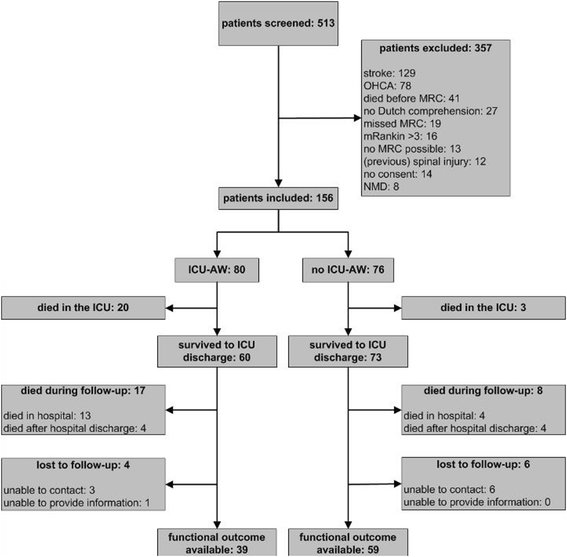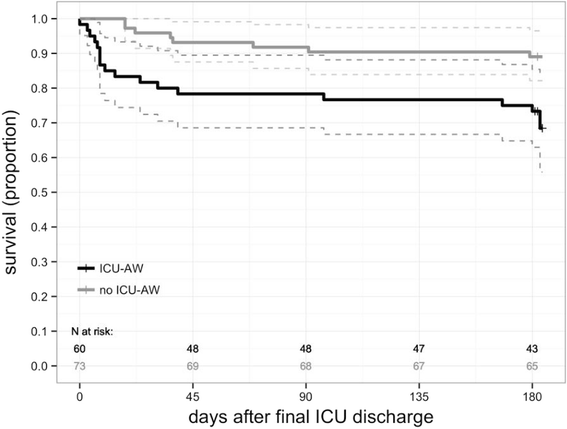Impact of ICU-acquired weakness on post-ICU physical functioning: a follow-up study
- PMID: 25928709
- PMCID: PMC4427976
- DOI: 10.1186/s13054-015-0937-2
Impact of ICU-acquired weakness on post-ICU physical functioning: a follow-up study
Abstract
Introduction: ICU-acquired weakness is thought to mediate physical impairments in survivors of critical illness, but few studies have investigated this thoroughly. The purpose was to investigate differences in post-ICU mortality and physical functioning between patients with and without ICU-acquired weakness at 6 months after ICU discharge.
Method: ICU patients, mechanically ventilated ≥ 2 days, were included in a single-center prospective observational cohort study. ICU-acquired weakness was diagnosed when the average Medical Research Council score was <4 in awake and attentive patients. Post-ICU mortality was recorded until 6 months after ICU discharge; in surviving patients, physical functioning was assessed using the Short-Form Health Survey physical functioning domain. The independent effect of ICU-acquired weakness on post-ICU mortality was analyzed using a multivariable Cox proportional hazards model. The independent effect of ICU-acquired weakness on the physical functioning domain score was analyzed using a multivariable linear regression model.
Results: Of the 156 patients included, 80 had ICU-acquired weakness. Twenty-three patients died in the ICU (20 with ICU-acquired weakness); during 6 months follow-up after ICU discharge another 25 patients died (17 with ICU-acquired weakness). Physical functioning domain scores were available for 96 survivors (39 patients with ICU-acquired weakness). ICU-acquired weakness was independently associated with an increase in post-ICU mortality (hazard ratio 3.6, 95% confidence interval, 1.3 to 9.8; P = 0.01) and with a decrease in physical functioning (β: -16.7 points; 95% confidence interval, -30.2 to -3.1; P = 0.02).
Conclusion: ICU-acquired weakness is independently associated with higher post-ICU mortality and with clinically relevant lower physical functioning in survivors at 6 months after ICU discharge.
Figures


Similar articles
-
Functional Recovery in Patients With and Without Intensive Care Unit-Acquired Weakness.Am J Phys Med Rehabil. 2017 Apr;96(4):236-242. doi: 10.1097/PHM.0000000000000586. Am J Phys Med Rehabil. 2017. PMID: 28301864
-
Respective contribution of intensive care unit-acquired limb muscle and severe diaphragm weakness on weaning outcome and mortality: a post hoc analysis of two cohorts.Crit Care. 2019 Nov 21;23(1):370. doi: 10.1186/s13054-019-2650-z. Crit Care. 2019. PMID: 31752937 Free PMC article.
-
Early mobilization and recovery in mechanically ventilated patients in the ICU: a bi-national, multi-centre, prospective cohort study.Crit Care. 2015 Feb 26;19(1):81. doi: 10.1186/s13054-015-0765-4. Crit Care. 2015. PMID: 25715872 Free PMC article. Clinical Trial.
-
Acquired Muscle Weakness in the Surgical Intensive Care Unit: Nosology, Epidemiology, Diagnosis, and Prevention.Anesthesiology. 2016 Jan;124(1):207-34. doi: 10.1097/ALN.0000000000000874. Anesthesiology. 2016. PMID: 26445385 Review.
-
ICU-acquired weakness.Chest. 2007 May;131(5):1541-9. doi: 10.1378/chest.06-2065. Chest. 2007. PMID: 17494803 Review.
Cited by
-
Which factors are associated with acquired weakness in the ICU? An overview of systematic reviews and meta-analyses.J Intensive Care. 2024 Sep 5;12(1):33. doi: 10.1186/s40560-024-00744-0. J Intensive Care. 2024. PMID: 39232808 Free PMC article. Review.
-
Long-term health-related quality of life, healthcare utilisation and back-to-work activities in intensive care unit survivors: Prospective confirmatory study from the Frisian aftercare cohort.PLoS One. 2022 Sep 7;17(9):e0273348. doi: 10.1371/journal.pone.0273348. eCollection 2022. PLoS One. 2022. PMID: 36070286 Free PMC article.
-
ICU-acquired weakness.Intensive Care Med. 2020 Apr;46(4):637-653. doi: 10.1007/s00134-020-05944-4. Epub 2020 Feb 19. Intensive Care Med. 2020. PMID: 32076765 Free PMC article. Review.
-
Assessment of Sarcopenia in the Intensive Care Unit and 1-Year Mortality in Survivors of Critical Illness.Nutrients. 2021 Aug 8;13(8):2726. doi: 10.3390/nu13082726. Nutrients. 2021. PMID: 34444886 Free PMC article.
-
Glucosafe 2-A new tool for nutritional management and insulin-therapy in the intensive care unit: Randomized controlled study (the Glucosafe 2 protocol).PLoS One. 2025 Mar 4;20(3):e0316624. doi: 10.1371/journal.pone.0316624. eCollection 2025. PLoS One. 2025. PMID: 40036206 Free PMC article.
References
Publication types
MeSH terms
LinkOut - more resources
Full Text Sources
Other Literature Sources

